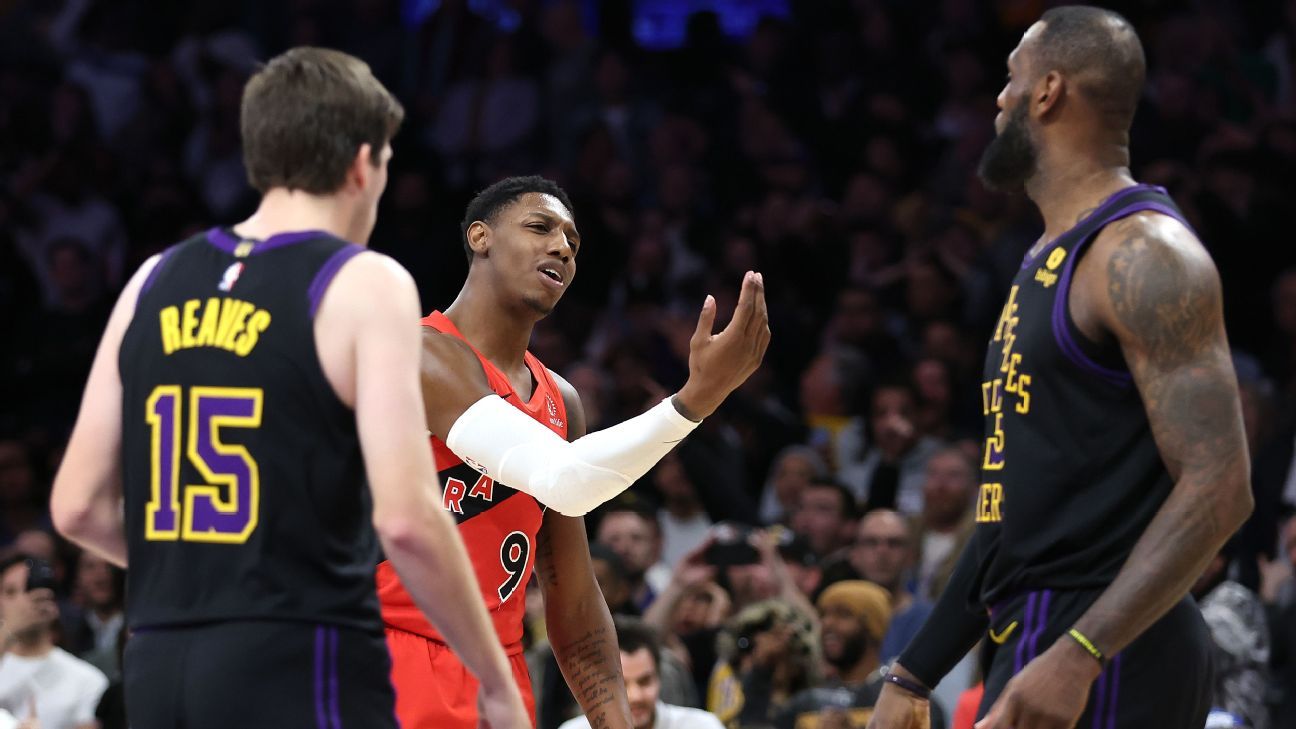In 1960, Northwestern athletic director Stu Holcomb bought a wild concept: A playoff in faculty soccer!
The previous Purdue soccer coach was a fan of the tournaments that had been taking root in sports activities corresponding to basketball and baseball, and he wished one thing comparable for the most well-liked faculty sport. He envisioned an eight-team enterprise together with the champions of the AAWU (the longer term Pac-10), ACC, Massive 8, Massive Ten, SEC and SWC, plus two at-larges (probably chosen among the many highly effective independents of the time), and he steered that among the income such a match would generate could possibly be diverted to the American Olympic Fund and different worthy causes corresponding to medical analysis. “It will be a beautiful factor if such a match may come about,” Holcomb instructed The Related Press.
For sure, the thought went nowhere. It earned a few rounds of newspaper headlines and loads of optimistic and hilariously adverse responses from newspaper columnists, but it surely vanished from the papers by the center of the 12 months. Discuss of a faculty soccer playoff would not actually resume till Michigan State coach Duffy Daugherty picked up the mantel a couple of years later. Nonetheless, considered from a present-day lens, it was a surprisingly noble proposal. Enjoying some additional soccer video games to each decide a real nationwide champion and lift cash for good causes? As naive because the proposal might need been, what’s to not admire about that?
Granted, the present Faculty Soccer Playoff, which got here into existence greater than 50 years after Holcomb’s proposal (and with half the groups), does find yourself sending some huge cash to Olympic sports activities within the type of funds for faculty groups. Nevertheless, the newly expanded playoff — 12 groups in 2024-25, then, as not too long ago rumored, seemingly 14 groups within the years that comply with — gives a equally noble alternative: to make sure there are as many athletic departments as doable able to fund the athlete compensation that’s coming down the pike in a single type or one other.
Editor’s Picks
2 Associated
As an alternative, that cash goes for use to ensure the SEC and Massive Ten increase their monetary benefits over everybody else.
In December, NCAA president Charlie Baker proposed rule modifications that may, for the primary time, permit Division I faculties to pay their athletes. “[It] is time for us — the NCAA — to supply our personal forward-looking framework,” he mentioned. “This framework should maintain the most effective components of the student-athlete expertise for all student-athletes, construct on the monetary and organizational investments which have positively modified the trajectory of girls’s sports activities, and improve the athletic and tutorial expertise for student-athletes who attend the best resourced schools and universities.” The proposal was unfastened with specifics, however the normal concept was that faculties in a newly created subdivision would pay at the very least $30,000 per athlete per 12 months for at the very least half their athletes, and people funds can be cut up equally between female and male athletes.
Baker’s proposal was clearly an try to go off what the court docket system could possibly be sending the NCAA’s method within the coming years. It faces athlete unionization efforts, antitrust lawsuits, truthful labor lawsuits and state regulation modifications, all of that are guiding (or shoving) it towards a participant compensation mannequin of some type. For years, its solely methods had been stalling in any respect prices or begging Congress for assist. Baker’s maneuver won’t find yourself being sufficient, but it surely was the primary progressive step the NCAA has taken on this matter, properly, ever.
Now, let’s do some back-of-the-napkin math. Relying on what number of sports activities a Division I program gives (and whether or not it gives funds to all of its athletes or simply the prescribed half), such a plan would theoretically price athletic departments between $4 million and $12 million per 12 months at minimal. Contemplating that the newest figures from USA At the moment’s monetary database (for public universities solely) present 49 public D-I packages took in income of at the very least $100 million in 2022-23, this could not be a very excessive bar for a lot of main athletic packages to clear, even when it takes a bit little bit of reconfiguring when it comes to different salaries, constructing initiatives, et cetera. However contemplating almost two-thirds of the packages at that stage took in lower than $40 million in income, this could be an impossibility for fairly a couple of different universities, at the very least with out reducing fairly a couple of sports activities groups.
Whereas we await official particulars from the forthcoming CFP tv contract, contemplating a 12-team CFP was set to attract one thing round $1.3 billion yearly, it is truthful to imagine a 14-teamer, with two additional first-round video games, could possibly be value one thing like $1.5 billion, about $900 million of which might be new and uncommitted funds. If divided equally amongst all 363 Division I packages, that may common out to $4.1 million per faculty, $3.4 million of which might be from uncommitted funds. If distributed to solely the 261 D-I faculties with soccer packages, that is $5.7 million per faculty ($3.4 million uncommitted). FBS faculties solely? $11.1 million per faculty ($6.7 million uncommitted). Give you a mix of the choices there, and you might cowl the overwhelming majority, if not all, of the potential prices from a $30,000-per-athlete plan.
Put one other method, this expanded playoff may pay for the way forward for faculty sports activities. And if the cash would not fairly work, then let’s be sincere: 14 groups is a extremely foolish quantity for a match — proposed by the SEC and Massive Ten to guarantee that there are two additional at-large bids for them to nab, plus solely two byes (that their champions would incessantly earn) — when 16 is correct there. So let’s make it 16. That seemingly provides one other $100 million to $200 million to the general annual pool. Hell, make it an FCS-style 24 groups if you would like. And go forward and log out on that NCAA basketball match growth, too — we have noble intentions right here! (Or at the very least, regardless of the “faculty sports activities making a number of cash” model of “noble” is.)
Each present dialog about the way forward for faculty sports activities hints at some foreboding universe by which paying athletes forces universities to drop sports activities and perhaps by accident destroys faculty athletics altogether. These conversations are nearly definitely overwrought — and the best way directors proceed to threaten the well being of girls’s sports activities specifically as a form of “hearken to us, or else!” menace within the compensation dialog continues to be notably gross — however this is an excellent, billion-dollar workaround. It may pave the best way towards a vibrant future.
This, in fact, will not be what is going on to occur. The commissioners of the expanded SEC and Massive Ten, Greg Sankey and Tony Pettiti, are utilizing this dialog as an event to extort concessions from the remainder of FBS.
Within the present CFP deal, every energy convention will get 16% of the set CFP income distribution, whereas the 5 different conferences and independents cut up the remaining 20% between them. There’s additionally a pool of cash distributed straight to colleges that qualify for the playoff. Even when each FBS program made the identical share of the assured distribution cash transferring ahead, the SEC and Massive Ten can be positioned to make much more annual income than the remainder of the pack due to their profitable media rights offers and the truth that, with their highly effective lineups, they’ll declare a big proportion of CFP bids.
That is not sufficient for them, nonetheless. They’re additionally demanding a a lot larger proportion of set income — current reporting suggests the SEC and Massive Ten will now mix for about 57% of the assured purse, whereas the ACC and Massive 12 (and Notre Dame) mix for about 34% and the Group of 5 groups and remaining unbiased will now cut up 9%. Principally, G5s will get a slight enhance in general income, whereas the Massive Ten and SEC enhance their take by about 280% when, once more, that they had a baked-in benefit to start with.
A superb enterprise mind would let you know that the brand new Energy 2 had huge leverage, the Massive 12 and ACC had little, and the Group of 5 had none, so this was simply how a correct negotiation ought to go. Zero-sum positive aspects and all. However it is a brand-new income stream, one that everybody may benefit considerably from, and this does not should be zero-sum — why is anybody making use of leverage in any respect? And the way a lot cash do you really need, anyway? Even dangerous SEC and Massive Ten groups will now make about $21 million yearly from the CFP whereas good G5 groups will make $1.8 million. It most likely goes with out saying that an Ohio wants $21 million much more than an Ohio State, however hey, the Buckeyes have the “leverage.” Infuriating, is not it?
Prime tales of the week from 
Get unique entry to hundreds of premium articles a 12 months from high writers.• Lowe: Harmful West group on the rise »• Rating NFL’s high 100 free brokers »• Prime 10 NHL rivalries: How about FLA-TB? » Extra ESPN+ content material »
We discuss a giant sport about how [insert topic of the day that we don’t like] goes to destroy faculty soccer. Convention realignment … a small playoff … a giant playoff … head accidents … focusing on penalties designed to chop down head accidents … gamers being profitable. In the event you don’t love some change, you declare it the loss of life of the game. These declarations have been proper 0% of the time. Possibly I am unsuitable this time, too. However to me, the largest present menace to school soccer’s future is the richest packages ravenous the remainder of the ecosystem and, in impact, relegating the remainder of main faculty soccer by making certain they do not have the income to correctly pay their athletes.
Need to truly do long-term harm to school soccer? Shrink the variety of packages that aspire to big-time ball, pressure some others to perhaps drop a subdivision (or drop soccer altogether) and shrink the variety of general scholarships obtainable to play the game (or any of the sports activities that may see groups dropped in droves). The SEC and Massive Ten have already got all the benefits. They already boast a lot of the packages able to profitable the nationwide title, and if or when Florida State and Clemson (and perhaps Miami) combat their method out of the ACC, they’re going to just about have all of them. However proper now, there are 134 universities prepared to shell out 85 scholarships per 12 months, plus loads of different advantages, and make investments hundreds of thousands of {dollars} simply to be a part of the FBS membership, make a bit more cash for his or her different packages, and hopefully go .500 and play in a minor bowl sport.
Inequality has all the time dominated this sport, however there has all the time been room for anybody who desires to speculate. Iowa State averaged greater than 60,000 in house attendance final season. NC State, its followers having by no means witnessed a top-10 end, averaged almost 57,000. East Carolina averaged over 35,000 whereas going 2-10. UConn hasn’t had a profitable season since 2010 and averaged almost 25,000. New Mexico State has completed over .500 in simply seven of its previous 56 seasons in top-division faculty soccer and drew almost 15,000 per sport. None of those faculties are long-term threats to LSU or Michigan. Possibly these attendance ranges would not drop in a world the place NMSU or UConn or ECU — and even NC State or Iowa State — are pressured to play ball in a unique subdivision as a result of they can not afford to pay what the SEC or Massive Ten is paying (although it most likely bears mentioning that over the previous 4 seasons that weren’t impacted by COVID, when an English Premier League group was relegated, its attendance fell by 9% on common, in line with TruMedia). However why the hell would we wish to discover out?
Is there something that would cease this ongoing energy seize? And can we care? Final 12 months, a survey administered by Sportico and the Harris Ballot discovered that 68% of respondents agreed convention realignment was “an issue in faculty sports activities,” however solely 18% mentioned realignment had truly diminished their enjoyment of it. Tv scores are going to be nice for all the brand new convention pairings the Energy 2 conferences will get away this fall — Georgia at Texas, Ohio State at Oregon, Alabama at Oklahoma, USC at Michigan, Oklahoma at LSU, Oregon at Michigan, Michigan at Washington, Washington at Penn State and, in fact, Texas at Texas A&M. We do not have a tendency to show “I do not like this” into “I am not going to observe this,” and we do not precisely have German soccer followers’ aptitude for sticking up for themselves. (These German protests labored, by the best way.) Would protests and sport interruptions at FBS faculties outdoors the SEC and Massive Ten have any impact? Would anybody even assume to attempt to stick up for themselves?
Within the ongoing debate about whether or not faculty soccer wants a commissioner determine — properly, it is not a lot a debate as everybody seemingly agreeing that one is required and nothing ever occurring — Greg Sankey’s identify nearly inevitably comes up. However his and Tony Pettiti’s decision-making appears to be the largest present menace to the school soccer ecosystem. (Faculty basketball, too.) If such a place had been to ever exist, I might want somebody who truly cares about all of school soccer and faculty sports activities.


























